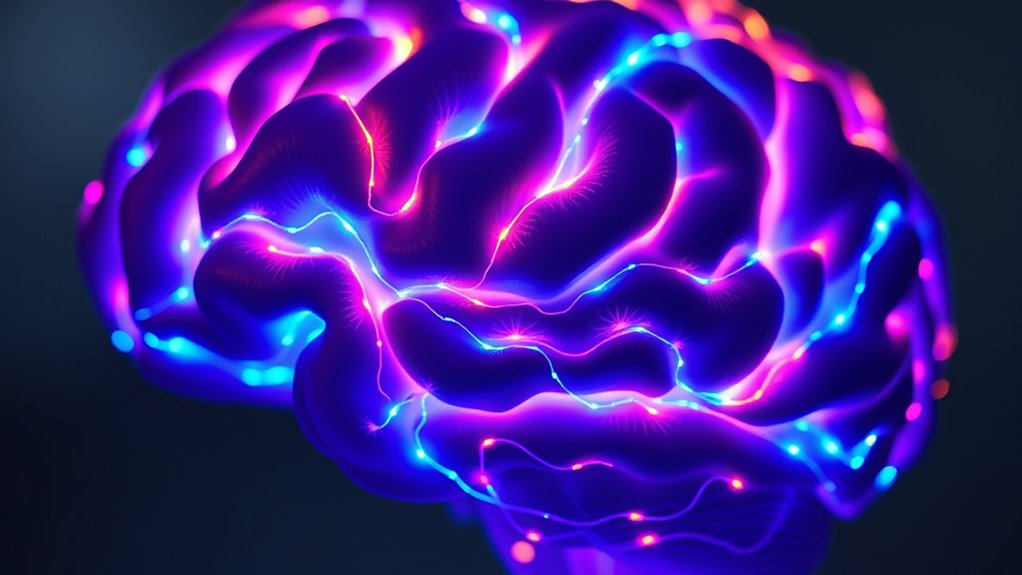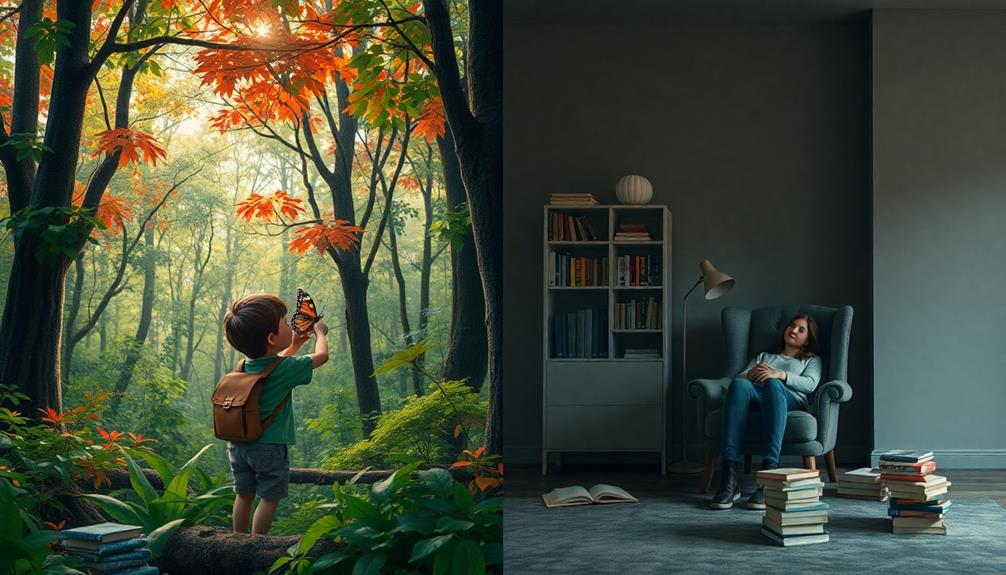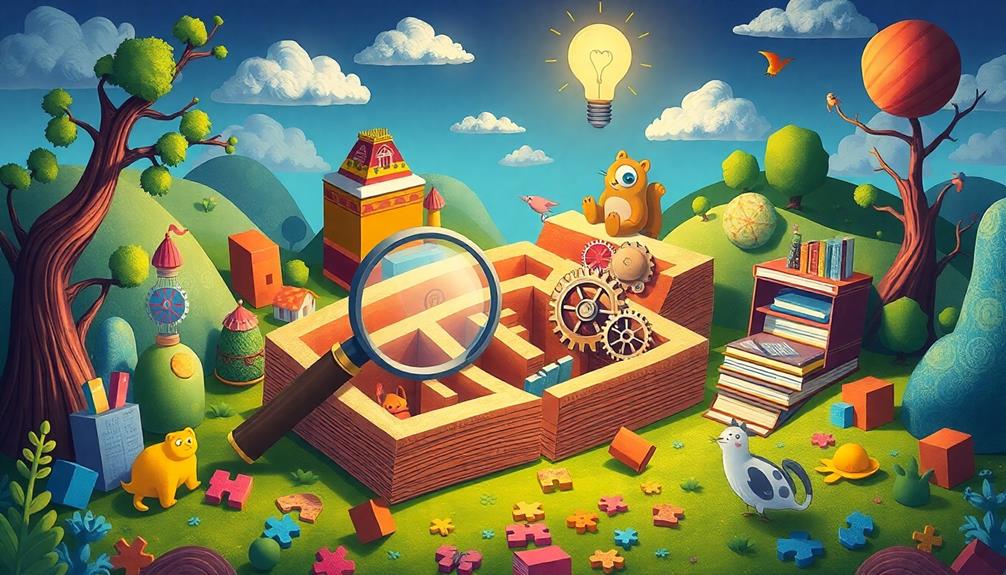When you encounter wonder or new questions, your brain activates specific pathways involving the prefrontal cortex and hippocampus, signaling your focus and curiosity. This triggers dopamine release, making you feel rewarded and motivating you to seek more knowledge. As you explore, these neurochemical boosts strengthen neural connections, improving your memory and fostering creativity. Curiosity constantly rewires your brain, enhancing your ability to learn and adapt—discover how these processes can open your potential even further.
Key Takeaways
- Curiosity activates brain regions like the prefrontal cortex and hippocampus, facilitating assessment and attention toward new information.
- Dopamine release during curiosity reinforces motivation, creating rewarding feelings that encourage ongoing exploration.
- Engaging curiosity strengthens neural connections, enhancing memory retention and transforming questions into knowledge.
- Curious states promote neuroplasticity, enabling flexible thinking and brain rewiring for creative problem-solving.
- Long-term curiosity-driven exploration reshapes brain architecture, supporting lifelong learning and adaptive cognitive functions.

Curiosity sparks your desire to learn and explore, but behind this instinct lies a complex network of brain activity. When you encounter something new or intriguing, your brain activates specific pathways designed to process and evaluate this information. These brain pathways, which involve regions like the prefrontal cortex and the hippocampus, work together to assess the potential value of the unknown. As you pursue answers, these pathways light up, signaling your brain to focus attention and gather more details. This process isn’t passive; it’s driven by a powerful neurochemical response involving dopamine release. When your brain detects a gap in your knowledge or encounters a puzzling situation, dopamine floods the synapses, reinforcing your motivation to seek out information. This dopamine release creates a feeling of reward, making you enthusiastic to satisfy your curiosity. It’s the same mechanism that underpins addiction and pleasure responses, but in the context of learning, it encourages you to keep exploring and discovering new things.
Your brain’s response to curiosity isn’t just about feeling good; it actively shapes your learning process. The dopamine release associated with curiosity enhances the strength of neural connections, making it easier to remember new information. When you’re genuinely interested in a topic, your brain prioritizes the relevant brain pathways, creating a heightened state of focus and engagement. This heightened state optimizes your ability to retain what you learn, as the neural pathways involved become more robust through repeated activation. In essence, curiosity acts as a catalyst that primes your brain for learning, turning abstract questions into tangible knowledge. The more you explore, the more these pathways strengthen, creating a positive feedback loop that fuels your desire to learn even more.
Furthermore, curiosity doesn’t just improve memory; it encourages creative thinking and problem-solving. When your brain is in a curious state, it’s more flexible and open to new ideas, because the neural circuits involved are more adaptable. Dopamine’s role here is vital—by promoting neuroplasticity, it helps your brain rewire itself in response to novel experiences, fostering innovative thought. So, every time you wonder about something and seek an answer, you’re not just satisfying a fleeting interest—you’re actively rewiring your brain. This process, driven by brain pathways and dopamine release, enhances your capacity to learn efficiently and creatively. Ultimately, curiosity isn’t just a fleeting emotion; it’s a fundamental catalyst that shapes your brain’s architecture, fueling lifelong learning and discovery. Additionally, understanding the color accuracy of your tools can further enhance how effectively your brain processes and retains new information.
Frequently Asked Questions
How Does Curiosity Influence Emotional Well-Being?
Curiosity boosts your emotional well-being by building emotional resilience and reducing anxiety. When you’re curious, you engage your brain in positive exploration, which helps you manage stress better. This sense of wonder encourages a growth mindset, making setbacks feel like opportunities rather than failures. As a result, you’re more adaptable and resilient, experiencing less anxiety and greater overall happiness, fostering a more balanced emotional state.
Can Curiosity Be Intentionally Cultivated or Enhanced?
You can definitely cultivate curiosity—who would’ve thought? By practicing mindful exploration, you train your brain to stay open and inquisitive. Curiosity training involves deliberately seeking new experiences and asking questions, turning everyday moments into opportunities for wonder. Ironically, curiosity grows stronger when you stop chasing it and start embracing uncertainty. So, with consistent effort, you can enhance your innate desire to learn and explore, making curiosity a habit rather than a chance occurrence.
What Role Does Curiosity Play in Creativity?
Curiosity fuels your creativity by sparking creative insights and encouraging innovative thinking. When you’re curious, you actively seek new ideas and perspectives, which leads to fresh solutions and unique concepts. Your inquisitiveness pushes you beyond conventional boundaries, allowing you to connect unrelated ideas and see opportunities others might miss. By nurturing curiosity, you enhance your ability to think outside the box and develop original, impactful creations.
Are There Differences in Curiosity Across Age Groups?
You’ll notice curiosity varies across developmental stages, with children showing the highest levels of wonder and adults often experiencing a curiosity decline. As you age, your curiosity can diminish due to changes in brain structure and priorities. However, maintaining an active desire to learn and explore can help counteract this decline, keeping your brain engaged and fostering continuous growth regardless of your age.
How Does Curiosity Affect Social Interactions and Relationships?
Your curiosity fosters trust building and improves social interactions by encouraging openness and understanding. When you ask questions and listen genuinely, others feel valued, strengthening bonds. Curiosity also aids conflict resolution, as it helps you see different perspectives and find common ground. By staying curious, you create a more empathetic environment where relationships grow stronger, and misunderstandings diminish. This active engagement makes your connections more meaningful and resilient.
Conclusion
As you explore the neuroscience of curiosity, remember it’s the spark that ignites your brain’s wonder engine, fueling learning and growth. Curiosity isn’t just a fleeting feeling; it’s the key to revealing your potential. Like a compass guiding you through uncharted territories, curiosity leads you to new horizons. Embrace it, nurture it, and let it transform every challenge into an opportunity. After all, isn’t life itself a grand adventure shaped by your insatiable desire to discover?








